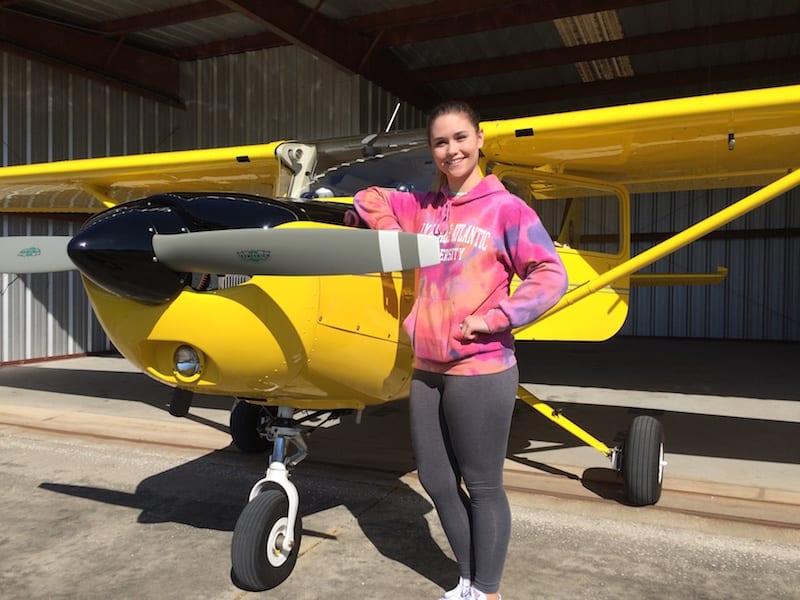
Something wonderful happened on Aug. 1, 2016, in the sleepy hamlet of Winter Haven, Florida. A flight instructor named Jim Porterfield rifled through pages in his student’s logbook, affixed his signature beneath the exact wording of a required endorsement, then climbed out of the C-150 he’d been instructing his student in.
He set his 17-year-old pupil free to challenge herself, armed with the skills and knowledge he’d passed on to her.
And so it was that Eirlys Willis (pronounced Eye-er-lease) achieved one of the great milestones of human accomplishment. She flew an airplane, by herself, launching into the sky and touching down on the runway three times before taxiing back to the hangar to have her tie-dyed t-shirt ruined and glorified at the same time.
Scissors were involved, as is traditional.

Eirlys Willis, moments after her first experience at the controls of an airplane in flight.
is a focused young woman of significant capabilities. Her parents are supportive of her desire to become a professional pilot, even though neither of them has any real experience in aviation.
She has persevered enough to find a community of aeronautical support to help foster her through the tougher parts of her journey, to help celebrate the victories with her, and to guide her along a path that will lead to ultimate success.
I know Eirlys Willis because she belongs to the same flying club I do. That’s as lucky for me as it is for her. We inspire each other.
A few days after her solo, I was planning on circulating the engine oil in my C-172, so I invited her to come along.
My plan was to let Eirlys share with me the actual function of an airplane, to take us from where we were, to where we wanted to go, then return safety to our starting point. In this case, where I wanted to go was Sebring Regional Airport, where we could have breakfast at the Runway Cafe. What actually happened was a very different experience.

Cessna 172. (Photo courtesy Cessna)
At the hold short line for Runway 23, Eirlys initiated our run-up. It wasn’t good. When she flipped the key to the left magneto, we saw an almost 300 RPM drop. The right mag was fine, dropping no more than 75 RPM.
Thinking we may have a fouled spark plug, I leaned the mixture, ran up the engine, waiting a reasonable period of time, and checked again. The 300 RPM drop re-occurred. I repeated the process only to get the same result. There was no question, we weren’t going flying. Instead, the airplane was going into maintenance.
I broke the news to my friend Eirlys while I suffered an interesting mix of embarrassment and irritation. I wanted to go. Both of us had been looking forward to the flight for days.
Now, we had no choice, I explained. To fly with a known problem would be irresponsible and potentially hazardous. The only choice left to us was the one we had the least interest in. Head back to the hangar, pop the cowl, and pull the plugs.
So we did. Eirlys enthusiastically grabbed a screwdriver, positioned herself on the opposite side of the cowl, and loosened fasteners along with me. She helped me remove the cowl and stow it away at the far side of the hangar. Then she assisted as I pulled plugs, skinned knuckles, and amazingly avoided using any language her mother would take me to task for.
We dropped the plugs off at my buddy Steve Alcorn’s hangar. Steve is a maintenance examiner who has a workshop filled with every tool or tester I could ever dream of. Better yet, his head is filled with more worthwhile maintenance information than mine will ever be and his hands are more skillful than most. With a big smile he agreed to test the plugs while Eirlys and I went off to breakfast locally.
Nothing was working out the way I planned it, but everything was working out great just the same.
Over breakfast downtown, Eirlys and I ran into another pilot who was enjoying a sunny morning on the ground with his wife. We chatted, swapped a few stories, agreed to meet in the flying club hangar that evening for a social gathering, and went our separate ways. Over time, my young friend learned an important lesson, then had it supported, and supported again.
Sometimes we cancel. That’s not something to be avoided. When the situation warrants it, we don’t make excuses or rationalize a rosy picture where one just flat out doesn’t exist. We cancel. It’s the right thing to do.
In the long run, the adversity of what turned out to be nothing more exotic than a bad spark plug taught a young student pilot an important lesson about how professional pilots handle problems. She found out first-hand that its better to address a concern directly than it is to press on and hope for the best – because the best just might be out of reach, and the worst is something we want to avoid to the best of our ability.
Cancellations happen. Disappointment is a part of life. But we managed to find the silver lining to our dark cloud that morning, and we made the best of it.
I know it made a positive impression because while I was wrenching on the spark plugs, Eirlys Snapchatted a picture of herself holding a screwdriver and standing in front of the airplane with the cowl removed. The caption she wrote was, “Hooray!”
That sounds like a win to me.
Source: http://generalaviationnews.comThe upside of adversity